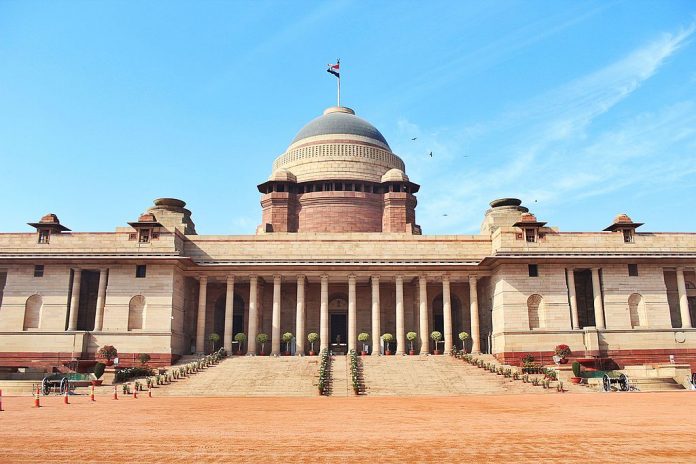This article is written by Soma-Mohanty of KIIT School of Law, Bhubaneswar. In this article, she has mentioned about the process of election of the president, eligibility to be the President and the reason why the indirect election is adopted in the election of the President.
The President of India is elected by a group of members forming an electoral college. The election of President of India is done according to the provisions of Article 55 of the Constitution of India.
Composition of an electoral college
The electoral college consists of
- The elected members of the Legislative Assemblies of the States.
- The elected members of both the Houses of Parliament.
Composition of Legislative Assemblies of the States
- Legislative Assemblies of each States shall consist of members not less than sixty and it should not be more than five hundred. This is regulated according to the provision of Article 333 of the Indian Constitution.
Composition of the Council of States
- The President nominates twelve members on the basis of skill or knowledge in literature, science, arts, and social service.
- Two hundred and thirty-eight representatives from the States as well as Union Territory.
Composition of the House of the People
- Five hundred and thirty members from territorial constituencies in the States who are chosen by direct election. The number of members should not exceed.
- Twenty members from Union Territories, who are chosen by the President according to the law. The number of members should not exceed.
Qualifications for president of India
Article 38 lays down the qualification required to be eligible for the President of India. The following criteria are:
- The person shall be a citizen of India.
- He should have attained the age of 35 years
- He must have qualified for election as a member of the House of the Parliament.
- When a person is holding an office of profit under the Government of India, or Government of any other State or under any local authority, then he won’t be eligible for the election of President.
- But the holder of certain offices are exempted from this provision.
- The President and Vice President
- The Governor
- Minister of Union as well as Minister of any State
Process of the election of the president of India
Uniformity in the scale of representation of states
- The proportionality between the value of the vote of an MLA to the population of that state is maintained.
- Formula.
Value of vote of an MLA= total no.of population of the particular state/ number of elected MLAs of that state divided by 1000.
The balance between the votes of MPs and MLAs
- To maintain the balance between the State and the Union, it has been formulated that the total value of votes of MPs should be equal to MLAs.
Single vote system
- Each voter has the right to cast only one vote
- The value of the vote of an MLA is variable and it varies from state to state.
- The value of the vote of MP always remains constant.
Fixed quota
- A winning quota is set up for the candidates.
- Whoever reaches the quota or exceeds it is declared as the winner.
- Formula
Winning qouta= total number of poll/ no.of seats + 1
Preference by electors
- In this type of election, the voter casts his vote in accordance with his preference
- The vote goes to the first preference.
- But if the first preference candidate fails to touch the winning quota and if any of the candidates did not touch the winning quota, then the vote goes to the second preference
Transfer of votes
- When after the count of the first preference vote is done and there is no winning candidate.
- Then the candidate who secured the lowest vote is eliminated.
- And after the elimination, the vote is transferred to the remaining candidates.

Proportional representation
- As per Article 55(3) of Indian Constitution the President of India is to be elected by proportional representation by the means of the single transferable vote.
- Minority parties, as well as independent candidates, are given a chance of representation and their chances of ruling increases. Thus, new changes are made in the system with evolution in the welfare of society as well as people.
- It provides the system of the coalition government. According to it under one government more number of voters can be represented.
- It is better than the ordinary straight voting system. Because in this system the candidates who are elected can’t represent the majority of the electorate’s opinion
How single transferable system works?
The single transferable system is mostly used in the representation. In this type of system, the elector has the right to one vote and the number of seats to be filled up is not required. Each voter can rank the candidates in accordance with their preference on the ballot paper.
The quota of surplus vote
The proportional representation system is different from an ordinary straight voting system. In the ordinary method, a candidate who secures the highest number of votes is declared to be elected. But in proportional representation, any candidate who secures the necessary quota is declared to be elected.
Process of calculating
Example
- the place “X” is a 5 seated constituency and the number of votes cast is 60,000.
- Then the total number of votes cast is to be divided by the number of constituencies plus one.
- That is 60,000 divided by (5 plus 1)
- 5 plus 1 equals to six
- 60,000 divided by 6 equals to 10,000
- 10,000 plus 1 is equal to 10,001
- Then after fixing the quota in this method, the candidate whose total number of first preference vote is more and the vote exceeds the quota fixed, is declared as the winner.
Distribution of surplus votes
The surplus vote of the first preference of each elected candidate would go in vain. Thus, those votes are transferred to the second preference candidate. The count of the surplus vote is known. This is the process of relocating excess votes.
Elimination of bottom candidate
- When all the seats are filled in the second round then the election is completed.
- Candidates with the lowest vote count of first preference are dropped out when the requisite number of candidates do not touch the quota while the distribution of surplus vote of first preference is done.
- Then the person’s complete vote is transferred to available preference to the next preference
- If these steps do not work effectively and still there is a vacancy of seats, then the procedure is repeated again. The candidate who is at the bottom is eliminated and all his votes are transferred to the candidate who is the next preference available according to his papers.
- This process is repeated until the seats are filled.
Working of proportional representation
Illustration
- Total no.of valid votes are 20,000
- There are four candidates “A”, “B”, “C”, “D”
- “A” has 8000 votes
- “B” has 7000 votes
- “C” has 4000 votes
- “D” has 1000 votes
- Quota of vote= {20000/ (1+1)}+1=10001
- One of them got the quota required for winning
- Thus “D” having the lowest vote would be eliminated and his vote would be transfered.
- Thus the vote would be distributed between “A”, “B”, “C”. now second preference would be recorded.
- The vote would be transferred to first preference i.e.
- “A”= 8000+200= 8200
- “B”= 7000+500= 7500
- “C”= 4000+300= 4300
- After the second count “c” secures the lowest vote and would be eliminated.
- The vote would be transferred to “A” and “B” respectively. And thus third preference would be recorded.
- Let the vote of “C”, divided between “A” and “B” be 1900 and 2400 respectively.
- The final result
- A’s count = 8200+1900= 10,100
- B’s count = 7500+2400= 9900
Thus “A” would be the winner as he has secured the quota of winning. The winning quota was 10001 and “A” had secured 10100
Reasons for indirect election of the President of India
- Our country has a cabinet system of government and thus it requires a competent person to run it. And it is not possible in part of the voters to differentiate the abilities the post requires to run the office and if the candidate possesses such abilities to run the office or not.
- If the direct election process for the election of the President would be adopted, then the candidate has to travel through India for campaigning for which he would require the help of a political party. This would arise political instability.
- The President is considered to be the first man of India and thus he deserves respect and his actions should be favourable towards all the parties for a swift running of the country. But direct election arises enmity feeling towards the President.
- India’s population is vast and conducting an indirect election for electing President would be expensive and it would affect the economy of the country even.
- It is not possible in the part of the Government to provide a huge number of electoral machinery for the smooth running of the election
- This system helps the head of State to maintain neutrality.
- In a direct election, the President elected may desire to have the real power as he was directly elected by people. And this would create a mess in the cabinet and thus the responsibility of each member would be in confusion.
To know more about President elections in India, please Click Here.
 Serato DJ Crack 2025Serato DJ PRO Crack
Serato DJ Crack 2025Serato DJ PRO Crack









 Allow notifications
Allow notifications



